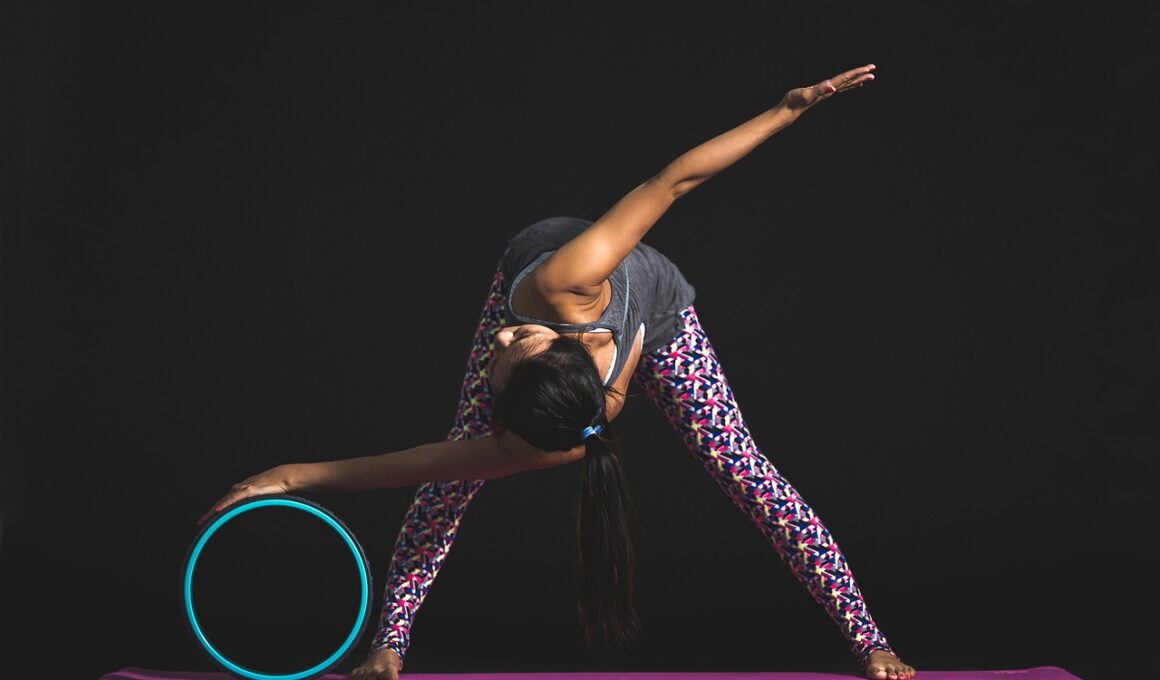Yoga App Features That Motivate Consistent Practice
In today’s fast-paced world, maintaining a regular yoga practice can be quite challenging. Many individuals turn to yoga apps for assistance in establishing a consistent routine. These applications are designed with features that provide motivation and help users engage in daily practice. One of the key elements is personalized goal-setting, allowing users to set specific objectives based on their own experience and lifestyle. Moreover, achievement tracking can contribute significantly to motivation, as users can visualize their progress over time. In addition, development of a community is essential, where users can connect with others pursuing similar goals. Integration of social sharing options enables participants to share their achievements and inspire others. Furthermore, instructional videos provide invaluable guidance, ensuring users practice safely and correctly. Another motivating factor is progress reminders, which prompt users to engage with their practice daily. Lastly, interactive elements such as gamification can inject fun into the learning experience, making users eager to return to the app. Users who actively participate in yoga through apps report higher levels of satisfaction and improved mental clarity, which are additional compelling reasons to embrace daily practice.
Essential Features of Yoga Apps
To create an engaging experience, yoga apps must incorporate essential features that resonate with users’ needs. A user-friendly interface is fundamental, ensuring navigation feels intuitive and seamless. Customized workout plans cater to individual skill levels, whether beginner, intermediate, or advanced. Voice-guided instructions provide an auditory element, aiding focus during practice sessions. The inclusion of meditation modules enhances overall well-being and mindfulness. Users often appreciate various yoga styles, such as Hatha, Vinyasa, or Kundalini, allowing for diversified experiences. Another appealing aspect is the ability to adjust audio levels, giving users control over background music or instructor guidance. Tracking metrics, such as session duration and calories burned, encourages users to challenge themselves. In addition, push notifications remind individuals of their scheduled sessions and promote accountability. Supporting multiple devices, the ability to access content on mobile, tablets, and desktops ensures flexibility in practice locations. Interactive challenges not only enhance motivation but also foster a sense of accomplishment. All these features combined contribute to a holistic user experience, making yoga more accessible and enjoyable, ultimately encouraging users to maintain their yoga practice regularly.
Incorporating feedback mechanisms within yoga apps can significantly enhance user engagement and motivation. Users appreciate when their experiences are taken into account, and reviews can lead to continuous improvements. An efficient feedback loop allows users to provide suggestions for new features or report technical issues. Regular updates informed by user feedback can foster a sense of community and connection with the developers. Additionally, yoga apps can introduce rewards programs that encourage consistency in practice. For instance, users could earn points for completing sessions or challenges, which can be redeemed for app features or merchandise. This gamification aspect can transform practice from a mundane task into an exciting journey. Moreover, motivational quotes and affirmations can be integrated into daily notifications, inspiring users to overcome mental barriers. Video testimonials from satisfied users can also reinforce the app’s credibility while encouraging newcomers to engage. Additionally, virtual events, such as live classes or community challenges, facilitate motivation by creating shared experiences. These enhancements not only drive user engagement but also create an environment where users feel supported and empowered in their yoga journey. Finally, such features contribute to higher retention rates among users, demonstrating the apps’ success.
Utilizing Technology for Motivation
In an age dominated by technology, yoga apps can leverage advanced tools to motivate users effectively. Features like augmented reality can enhance the user’s experience, allowing them to visualize poses and adjustments in a detailed format. With the use of machine learning, apps can analyze user behavior and provide tailored recommendations that suit individual preferences. Additionally, fitness trackers can sync with yoga apps, providing valuable health data and promoting a more comprehensive wellness journey. Users appreciate the idea of notifications that remind them to practice based on previous habits, ensuring that consistency becomes a part of their routine. Furthermore, allowing users to choose music during practice sessions can create a more personalized atmosphere, encouraging longer engagement. Incorporating mindfulness activities, such as breathing exercises or guided meditations, can further motivate users to connect deeper with their practice. Utilizing technologies to create an immersive experience can inspire commitment and foster a sense of community. The inclusion of live streaming sessions can also bridge the gap between users and instructors, enhancing interactivity and interest. Through these innovations, yoga apps can revolutionize the practice experience and stimulate consistent engagement from diverse users.
Personal progress tracking features can serve as a powerful motivator for users of yoga apps. When individuals can visually see their improvements over time, they are more likely to maintain their commitment. Instead of just completing a yoga session, users can track metrics like their flexibility, strength, and endurance. For example, integrating tools that highlight personal bests during specific poses can create a sense of accomplishment. Additionally, plastering reminders within the app that highlight personal achievements can boost user morale. Including pre-set challenges can motivate users to push beyond their limits, inspiring them to try more advanced routines. Moreover, completing a series of workouts can unlock badges or other forms of recognition, providing tangible rewards for dedicated practice. With such tracking, users can clearly understand their evolution within the practice, thus encouraging them to remain consistent. As users see their progress documented, they can build confidence over time, reinforcing their desire to continue. Sharing these achievements through social media platforms can further amplify the excitement and inspire others, creating a cycle of motivation that can extend beyond the individual user to the larger community.
The Importance of Community Support
Community support plays a significant role in maintaining motivation in yoga practice. Yoga apps that foster a sense of belonging can significantly enhance the user experience. Virtual communities enable individuals to connect with like-minded enthusiasts who share similar goals. Through built-in forums or groups, users can discuss tips, share progress, and celebrate achievements together. These interactions can lead to shared challenges or live sessions, creating opportunities for collaborative practice. Additionally, structured programs that promote collective goals can enhance motivation, as users feel accountable to each other. Many yoga apps introduce features that allow users to join group sessions where they can practice simultaneously, despite being in different locations. Such community interactions provide a support network, particularly for beginners who may feel intimidated. Moreover, receiving encouragement and feedback from peers can drive individuals to push their limits. Unique features, such as leaderboards, can instill a spirit of friendly competition, promoting consistent practice. Ultimately, the sense of community cultivates a supportive environment that motivates users consistently to return to their yoga practice. Through these peer connections, participants can better navigate their journey without feeling isolated in their yoga endeavors.
In conclusion, successful yoga apps must integrate various features that collectively enhance user motivation and promote consistent practice. Key aspects include personalized goal-setting, achievement tracking, and community support. Together, these elements form an ecosystem that supports users in their yoga journey. The user experience can be further enriched through the incorporation of technology, such as augmented reality and machine learning, which personalize the yoga experience according to individual preferences. Progress tracking features will drive users to remain steadfast in their practices, as they visualize improvements over time. Additionally, fostering a sense of community among users encourages motivation through shared experiences and allows for the exchange of supportive advice. Gamification elements not only make yoga enjoyable but reinforce consistent engagement. With various instructional resources and integration of meditation practices, yoga becomes even more accessible. Importantly, these features collectively cultivate an environment in which users can thrive, reconnecting both mental and physical health through regular practice. Overall, yoga apps stand as a bridge to achieving wellness goals while promoting discipline and mindfulness, ensuring that users maintain their motivation to consistently practice yoga and embrace the journey.
Integrating Mindfulness with Yoga Practice
Integrating mindfulness with yoga practice offers a powerful way to enhance physical and mental well-being. Many yoga apps now include guided sessions that emphasize breathing techniques and meditation practices. This combination can significantly deepen the user’s experience, fostering a more profound connection between mind and body. Regular practice of mindfulness not only improves focus during yoga sessions but also helps individuals manage stress effectively in daily life. Moreover, adding features that encourage reflection after each session can help users process their feelings and thoughts. Journaling prompts and guided reflections within the app create space for users to articulate their experiences. This holistic approach encourages consistent practice by highlighting the emotional benefits of yoga. Additionally, monitoring mental well-being and emotional growth over time provides insights into how yoga contributes to overall health. Incorporating soothing sounds and mindfulness reminders can create an immersive atmosphere during practice, promoting relaxation and concentration. With such comprehensive integration of mindfulness, yoga apps appeal to users seeking both physical fitness and mental serenity. This dual focus ensures that individuals remain motivated to regularly practice, embracing both the physical and mental benefits yoga offers.


